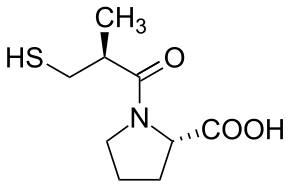Captopril challenge test
The captopril challenge test (CCT) is a non-invasive medical test that measures the change in renin plasma-levels in response to administration of captopril, an angiotensin converting enzyme inhibitor. It is used to assist in the diagnosis of renal artery stenosis. It is not generally considered a useful test for children,[1] and more suitable options are available for adult cases.
| Captopril challenge test | |
|---|---|
 Captopril chemical structure. | |
| Purpose | measures the change in renin plasma-levels |
Procedure
Plasma concentration of renin is measured prior to and following the administration of captopril. The CCT is considered positive if the renin levels increase substantially or the baseline renin level is abnormally high.[2] An abnormal captopril test is indicative of the presence of renovascular disease.
In adults
CCT in adults is known to have high sensitivity, but a low specificity.[3]
Subtraction angiography is considered a more suitable test for renal artery stenosis in adults.[4]
See also
- captopril suppression test used to diagnose primary aldosteronism
References
- Gauthier B, Trachtman H, Frank R, Pillari G. Inadequacy of captopril challenge test for diagnosing renovascular hypertension in children and adolescents. Pediatr Nephrol. 1991 Jan;5(1):42-4. PMID 2025535.
- Muller FB, Sealey JE, Case DB, Atlas SA, Pickering TG, Pecker MS, Preibisz JJ, Laragh JH. The captopril test for identifying renovascular disease in hypertensive patients. Am J Med. 1986 Apr;80(4):633-44. PMID 3515933.
- Bales A. Hypertensive crisis. How to tell if it's an emergency or an urgency. Postgrad Med. 1999 May 1;105(5):119-26, 130. PMID 10335324.
- Svetkey LP, Himmelstein SI, Dunnick NR, Wilkinson RH Jr, Bollinger RR, McCann RL, Beytas EM, Klotman PE. Prospective analysis of strategies for diagnosing renovascular hypertension. Hypertension. 1989 Sep;14(3):247-57. PMID 2670763.